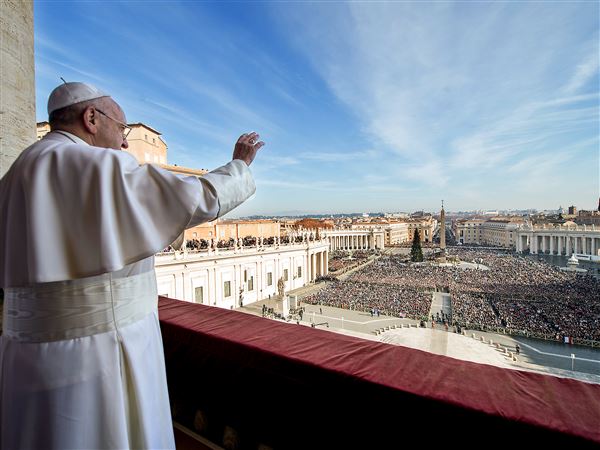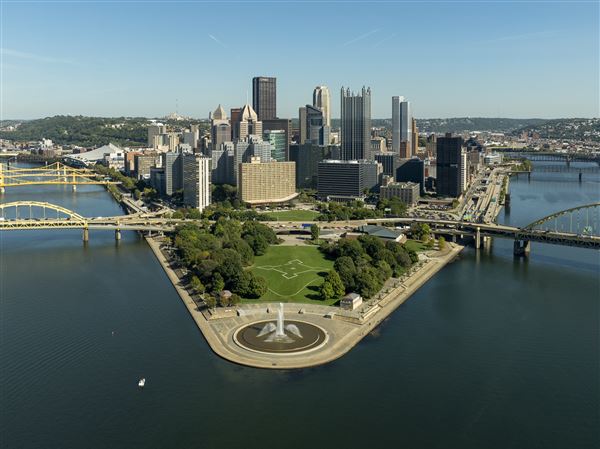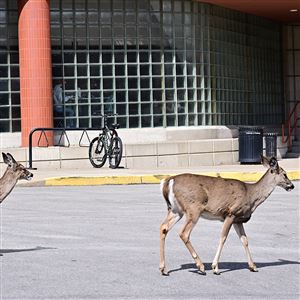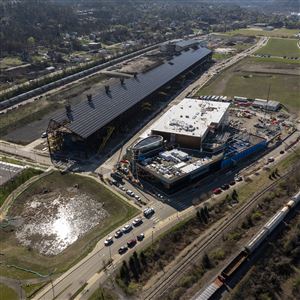At first, many people didn't even see the water for all it was plowing before it.
The estimated 37-foot-high torrent that exploded into Johnstown on the afternoon of May 31, 1889, had carried away so much in its 14-mile rampage down the Little Conemaugh River valley that one survivor recalled it as a "dark mass in which seethed houses, freight cars, trees, and animals."
In minutes, the entire contents of a man-made lake surged through this Cambria County industrial city, situated deep in a valley within the Laurel Highlands. Some 2,209 people were crushed, drowned or incinerated after the debris caught fire. Thousands became homeless. Johnstown became an epicenter of disaster relief and telegraph-era news coverage -- and a byword for the Gilded Age's class struggle.
Generations would pass before terms such as 1-percenter, superstorm and climate change entered the national vocabulary -- and the term "underwater" would itself enter the lexicon of mortgage finance.
But 125 years after the great Johnstown Flood of 1889, Pennsylvania's deadliest disaster continues to resonate in fields as diverse as ethics, water physics, legal theory, the growing economic divide and the increasingly fraught relationship between humans and their natural environment.
The disaster followed the catastrophic failure of the poorly maintained South Fork Dam at Lake Conemaugh, the exclusive resort of Pittsburgh's industrial elite -- including families whose names still adorn the Steel City's landmarks and skylines, such as Carnegie, Frick, Mellon, Phipps and Reed.
This week, Johnstown plans to commemorate the flood through religious services, readings of the victims' names and accounts of the flood, solemn music and other activities. Bells will ring through the valley, and 2,209 luminarias will be lighted in the evening along the dam ruins at the Johnstown Flood National Memorial.
"The flood story holds its fascination and relevance 125 years later," said Shelley Johannson, director of marketing and communications at the Johnstown Area Heritage Association. "The anniversary commemoration gives us a chance to look back at this defining event in the nation's history, and celebrate and recognize how far Johnstown has come as a community."
Even more than a century afterward, new artifacts and eyewitness documentation have come to light, and researchers are still filling in the story.
One recent study found that the South Fork Fishing and Hunting Club did an even worse job than previously documented in maintaining the dam. Another found that while the rich, powerful club members never paid a cent in legal damages, the disaster brought such outrage that American courts swiftly began expanding plaintiffs' rights to sue for damages in cases of industrial destruction -- even from defendants named Carnegie.
And the disaster fueled debate in the Gilded Age on issues -- the widening income gap, the outsized influence of money on the political process and justice system -- that resonate today in an era when the proverbial 1 percent consolidate a growing share of the nation's wealth.
"This was when the term robber barons was coined," said Richard Burkert, president of the Johnstown Area Heritage Association. "The concern at the time was, can you have a viable democracy when great wealth controls the political process? And even in the case of horrible accident like this, you have a group of people who are above the law, which is the way Victorian Americans saw this."
Natural forces, human assist
The flood also looks like a forerunner of modern disasters, such as hurricanes Katrina and Sandy, in which natural forces were aggravated human-caused factors such as coastal erosion, engineering failures and flood-plain development.
The Johnstown Flood "is very much a natural disaster in quotation marks," said Megan O'Malley, chief of interpretation at the Johnstown Flood National Memorial, run by the National Park Service at the site of the former Lake Conemaugh.
Yes, it was raining heavily on May 31, 1889, inundating Johnstown and much of Pennsylvania even before the dam failed. But nature didn't put 15 million tons of water behind that poorly maintained earthen dam.
"There is a very strong environmental component that is beyond the control of humans, but you can't escape the fact that there are very, very substantial and clear examples of human negligence," Ms. O'Malley said.
Nobody was attempting to kill 2,000 people, but "there's an element of being indifferent that is extremely sinister, too," she added.
The South Fork Dam was originally built by the commonwealth to hold water that supplied a canal system --which quickly went out of business. The dam deteriorated under later owners before passing on to the South Fork Fishing and Hunting Club, whose members used Lake Conemaugh to sail, fish, socialize and escape the heat of Pittsburgh and the pollution of their own industries.
It has long been known that the club-supervised renovations on the dam actually weakened it in many ways -- lowering its height to accommodate a carriage-way, neglecting to repair a sag in its center, failing to replace drainage pipes that had been scrapped by a previous owner and installing a fish screen on the spillway that was fatefully clogged with debris on the day of the flood.
But the list of flaws only grew in a recent study of the dam by University of Pittsburgh at Johnstown researchers.
The dam once had a second spillway, but the club rendered it useless by lowering the dam below its entry point, the report said. And to patch holes in the dam, the club had used porous clay and other weak materials, which crumbled away on the day of the flood.
The ethical responsibility is unmistakable, the researchers wrote in a 2013 article in the journal Pennsylvania History: "It is hard to imagine what else the [club] could have done to invite the forthcoming disaster."
The study also concluded that the dam burst earlier than previously believed -- shortly before 3 p.m. rather than after -- and that the lake re-formed twice on its way to Johnstown. Each time the waters got stuck behind railroad viaducts jammed with debris before bursting through with reloaded energy before entering Johnstown with enormous force.
The flood offers a cautionary tale today in an era of worsening flood-and-drought cycles attributed to climate change, said one of the researchers, Carrie Davis Todd, now professor of geology at Baldwin Wallace University in Ohio. "As the rest of our infrastructure continues to age, the likelihood of failure [grows], especially with more extreme precipitation and high-water events," she said.
The club's skillful defense
At the time, some thought it was blasphemous to call the flood an "act of God," either as a theological term or a legal euphemism for nature. "A jury of Pennsylvania Lutherans, Reformed Dutch, Presbyterians, Methodists, Baptists or Catholics will not take readily to the attempt to cast the responsibility of such a catastrophe from the shoulders of the fine rich gentlemen who owned the fish pond and the rotten dam to the shoulders of God," said the influential American Law Review.
But the lightly capitalized club was skillfully defended by the law firm Knox & Reed, forerunner of today's Reed Smith, and even those cases that reached a jury failed. It's not clear why because documentation of the cases is minimal. But Jed Handelsman Shugerman, a Fordham University law professor, has written that the plaintiffs' main challenge was pinning responsibility on not just the club but its individual members.
Before the flood, many American courts had made it hard to sue industry and its captains, with the Pennsylvania Supreme Court absolving a mining company in 1886 of polluting a neighbor's land by saying "personal inconveniences ... must yield to the necessities of a great public industry."
But almost overnight after Johnstown and other dam breaks, courts in many states began holding industries to the British standard of "strict liability," meaning they had to pay damages for the messes they created without the plaintiff having to prove negligence.
"A series of terrifying experiences with the [industrial] revolution's darker side made the industrial age's risks more salient," Mr. Shugerman wrote in a study of the flood's legal fallout.
Pennsylvania's top court practically ate its own earlier words when it ruled that Carnegie Bros. & Co. in 1891 could be held liable for polluting a neighbor's farm with its coke works. "The production of iron or steel or glass or coke [is] of great public importance," but the neighbors "stand on equal ground" before the law, the court ruled.
Had the flood lawsuits succeeded, there's no telling what would have happened to the fortunes that seeded what are today U.S. Steel, the law firm Reed Smith, Carnegie Mellon University, the Frick Art and Historical Center, the Phipps Conservatory and the Carnegie libraries, museums and philanthropies.
Tragically, 1889 wasn't the last time floodwaters wreaked devastation in and around Johnstown. Like much of Western Pennsylvania, the city was flooded during the deadly St. Patrick's Day storms of 1936, and torrential rains broke more dams in 1977, killing 85.
Today, as Johnstown works on renovating everything from its historic buildings to its rivers, it is also confronting the longer-range ecological costs of the industrial age. When residents commemorate the flood next weekend, they will do so at waters considerably cleaner than the discolored waters of years past.
"This whole heedless, headlong development that characterized the 19th century -- really the consequence of that is laid bare by the suffering of people here in Johnstown," Mr. Burkert said. "It's really taken 100 years or more to begin to address that legacy of environmental damage."
Upcoming events
Following are some events marking the 125th anniversary of the Johnstown Flood.
TODAY
• Blessing of the Little Conemaugh River. Begins from St. John the Baptist Orthodox Church, 427 First St., East Conemaugh, around 10:20 a.m., with a procession to the river.
• Odd Fellows Memorial Service. Grandview Cemetery IOOF monument, directly across from the Plot of the Unknown, 1 p.m.
Thursday
• Dramatic reading of an unpublished firsthand account of the 1889 flood. Cambria County Library, 6 p.m.
Friday
• Presentation of the 1926 silent film "The Johnstown Flood," accompanied by the nine-piece Ivy Leaf Orchestra. Grand Halle on Broad Street. Doors open 6 p.m., with presentation at 7 p.m. $8/$10.
Saturday
• Walking tours of downtown Johnstown, flood sites. Programs, maps at Johnstown Flood Museum, 304 Washington St., 11 a.m.-2 p.m.
• Film "Black Friday," on the hour at Johnstown Flood National Memorial, 733 Lake Road, South Fork, 9 a.m.-1 p.m. and 5-10 p.m.
• Kathleen George presents her new novel, "The Johnstown Girls," Johnstown Flood Museum, 1 p.m.
• Session on three key telegraph messages issued the day of flood, noon-3 p.m., Johnstown Flood National Memorial.
• History of the South Fork Dam vignettes, outside Unger House near Johnstown Flood National Memorial, 2 p.m.
• National Dam Safety Awareness Day, Peoples Natural Gas Park, 2-3:30 p.m.
• Ceremony and bell ringing, Johnstown Flood National Memorial, beginning shortly after 3 p.m. to mark the dam break. Church bells will ring down the valley to Johnstown.
• Ceremony marking the moment at 4:07 p.m. when the flood wave struck Johnstown; presentation by author and Johnstown native Michael Novak, Peoples Natural Gas Park.
• Presentation of British composer John Rutter's "Requiem" by Greater Johnstown Diocesan Festival Choir and members of the Johnstown Symphony Chorus, St. John Gualbert Cathedral, 117 Clinton St., 6:30 p.m.
• Evening lighting of Johnstown Stone Bridge to evoke events of the flood.
• Dinner and reader's theater based on first-person testimony about the flood and its aftermath. Peoples Natural Gas Park and Polacek Pavilion, 7:30 p.m. $25 plus fees.
• Luminaria at the dam site and reading of the names of the victims, Johnstown Flood National Memorial, 7-11 p.m.
NEXT Sunday
• Path of the Flood Historic Half Marathon and 5K. From St. Michael to downtown, 9 a.m.
• Interdenominational service. Includes wreath-laying ceremonies. Grandview Cemetery, 12:30 p.m.
• Community Heritage Day, including traditional craft demonstrations, music, dance. Peoples Natural Gas Park, noon-5 p.m.
• Family-Friendly Historic Walking Tour: Downtown Johnstown Then and Now. Peoples Natural Gas Park, 2 p.m.
• Guided tours of the second floor of the South Fork Fishing & Hunting Clubhouse; Journey Around the Lake Conemaugh van tours. Johnstown Flood National Memorial, all day.
• • • •
Peter Smith: petersmith@post-gazette.com or 412-263-1416; Twitter @PG_PeterSmith.
First Published: May 25, 2014, 3:57 a.m.

















